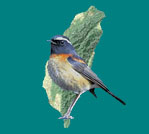 |
|
||||||||||||
|
|
|||||||||||||
 |
|
||||||||||||
|
|
|||||||||||||
|
Endemic Species White-whiskered Laughingthrush
Yellow Tit
Endemic Sub-Species
More Birds in Taiwan
|
Formosan Whistling-Thrush Myiophoneus insularisEndemic The Formosan Whistling-Thrush is a large thrush, about 30-32 cm long. Both sexes are a shiny deep blue that varies from sapphire to deep purple to black depending on the light. The eye is red. Their preferred habitat is damp, dark ravines in mountain forests near fast-flowing streams. Along Taiwan’s north coast, they may be found from sea level to 2400 m elevation, but primarily between 400 and 2100 m elsewhere. They can sometimes be seen standing on river rocks, slowly fanning and raising their tails. Their diet includes earthworms, insects, small frogs, fish, crabs, lizards and snakes. This species is fairly common but rather shy, most active at dawn and dusk. The call is a sharp, loud, high-pitched whistle which has been likened to the sound of screeching bicycle brakes. The slow, unhurried song is a mixture of shrill whistles, scratchy notes, melodious phrases and short trills. The nesting season of Formosan Whistling-Thrush begins in April and continues into July. The nest is a large, shallow cup constructed primarily of roots, moss and twigs, placed in cavities of trees and rocks, among tree roots, under bridges, in tunnels and sometimes on man-made objects. Females lay a clutch of usually two to four eggs that are light pink sprinkled with brown or grayish spots. Both parents incubate the eggs and care for the nestlings. Local common name: glass bird.
References: The Complete Guide to Birds in Taiwan, by Jin-yuan Wang
www.gio.gov.tw/info/ecology/English
|